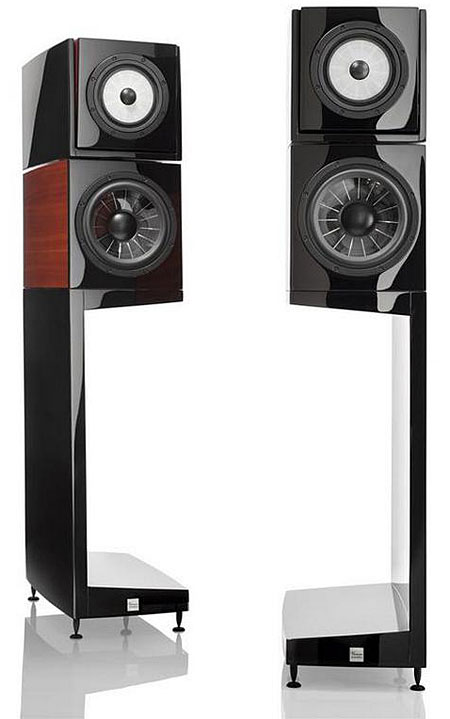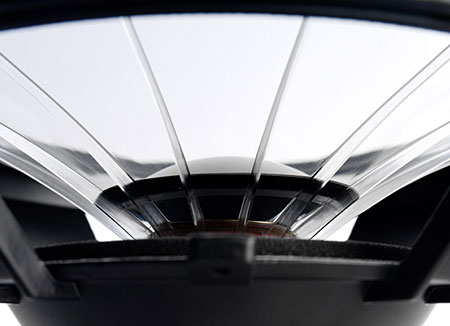| Columns Retired Columns & Blogs |
Vienna Acoustics Klimt The Kiss loudspeaker Page 2
Although The Kiss is (sort of) a stand-mounted speaker, dainty it ain't. Almost 2' deep, it occupies about the same footprint as many floorstanders. Also, despite a higher-than-average specified sensitivity of 89dB, it wants a bit of welly from accompanying amplifiers.
My only other setup-related thought is that the asymmetrical stands may not anchor The Kiss as well as a less stylish solution might. Even with meticulous leveling, mine rocked a bit, until I placed 25-lb York barbell plates on their bases—inelegant but effective.
Kill then, and bliss me / But first come kiss me
When I listened to John Surman's composition "Stone Ridge," from Tomasz Stanko's From the Green Hill (CD, ECM 1680), Anders Jormin's powerful double bass propelled the music along with authority and an astonishing amount of physicality. It wasn't so much that I had to keep reminding myself that The Kiss is a full-range three-way—the sound took care of that—but I was consistently amazed by how extended the bottom end was.

At the same time, Dino Saluzzi's bandoneón was remarkably present—I could hear the breath through its reeds, not to mention the shimmer of their harmonic overtones. Ah, and then Stanko enters. Holy Moly! The Kiss had jump factor aplenty. Stanko's trumpet was powerful, mellow, and utterly convincing.
That sense of presence wasn't a coloration, as demonstrated by "Oh Shenandoah," from Rambling Boy: Charlie Haden Family & Friends (CD, Decca B0011639). Pat Metheny's guitar and Jerry Douglas's dobro had pop and zing for sure, but The Kiss clearly revealed that Haden himself is no professional singer—his wispy voice lacked the projection of the pipes of daughter Petra Haden and guest star Rosanne Cash. That's not a criticism of Haden or The Kiss—in fact, the combination made me tear up every time I heard it.
The Kiss was exquisitely capable of revealing the emotional core of every type of music I played through it. There are speakers that I judge accurate but never really warm up to. The Kiss was not one of them. Part of its cuddle factor may well have been the seamless response of its midrange driver. Certainly, Vienna Acoustics isn't wrong when they point out that this driver alone covers the entire vocal range—which you'd think would beat any multiple-driver combination, which of course would require the services of a crossover somewhere in there.
Not to slight The Kiss's tweeter—the crossover to it was seamless and perfectly balanced. All of Haden's guest string players on Rambling Boy—Metheny, Douglas, Sam Bush, Ricky Skaggs, et al—sounded immediate (and, of course, different), with the requisite amount of floating overtones. Accurate, yes, but not overdone.
As a counterpoint to the Haden disc, I listened to the dance movement of Suite Castellana, from David Russell's Music of Torroba (CD, Telarc CD-80451). Russell's classical guitar had a darker tone than the steel-string dreadnaughts on Rambling Boy, of course, with a duller (albeit still vivid) overtone structure. Russell was also unambiguously placed within the acoustic of his favorite recording venue: Mechanics Hall, in Worcester, Massachusetts. While Russell was clearly somewhat closely recorded, The Kiss got out of the way of the hall's acoustic, allowing me to hear the support and amplification of that good room.

The Kiss also surprised me repeatedly, even when I wasn't listening attentively. Waiting for my wife to get off work one day, I had my music server on Shuffle and up popped "The Jezebel Spirit," by David Byrne and Brian Eno. Distracted by that week's New Yorker, my first thought was, I've always liked this song. After a minute, it occurred to me that, this time, I wasn't really liking this song. I wandered over to the server's display and saw that I was listening to an old mastering, 1993's Eno Box II: Vocal (CD ripped to ALAC, Virgin 39114) rather than the superior 2009 remastering of My Life in the Bush of Ghosts (CD ripped to ALAC, Nonesuch 79894). So I switched, naturally, and was immediately greeted with the punchy bass, bright percussion effects, and various screeches I'd thought I remembered so well.
I listened once, turned up the volume and listened, and did my little white-boy dance—and then I did what any audiophile would do: I deleted the file from Eno Box II.
On another day, I was idly listening to the Mothers of Invention's Burnt Weenie Sandwich (CD, Rykodisc RCD-10509) when I was knocked out by the live-sounding drums in "The Little House I Used to Live In." As a lifelong Zappa freak and audiophile, I know better than to expect sonic integrity from most of his recordings—he loved to edit together snippets from different dates and sessions, wasn't above using a variable-speed oscillator to convert one key to another, and audio verité just wasn't his thing.
- Log in or register to post comments




































